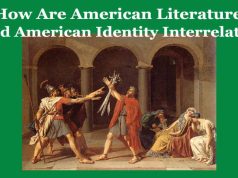What is Imagery in Literature

What is Imagery in Literature
Introduction:
In literature, imagery is a literary device that involves the use of vivid and descriptive language to create mental images, sensory experiences, and evoke emotions in the reader. Writers employ imagery to paint a more detailed and sensory-rich picture of their ideas, characters, settings, and themes, allowing readers to engage more deeply with the text. What is Imagery in Literature
Definition of Imagery:
Imagery involves the use of words and phrases that appeal to the reader’s senses, such as sight, sound, taste, touch, and smell. By incorporating sensory details, writers aim to stimulate the reader’s imagination and create a more immersive reading experience.
Types of Imagery:
Visual Imagery:
Descriptions that appeal to the sense of sight, help readers visualize scenes, characters, and settings more vividly. What is Imagery in Literature
Example: “The emerald-green leaves rustled in the gentle breeze as the golden sun dipped below the horizon.”
Auditory Imagery:
Language that creates sounds in the reader’s mind, enhancing the auditory experience of the narrative.
Example: “The distant waves crashed against the rugged cliffs, their rhythmic roar echoing through the serene coastal evening.”
Olfactory Imagery:
Words that evoke smells, adding a sensory layer to the writing.
Example: “The aroma of freshly baked bread wafted through the air, enticing passersby with its warm and comforting embrace.”
Gustatory Imagery:
Descriptions related to taste, allowing readers to imagine flavors and sensory experiences associated with food or drink.
Example: “The tangy sweetness of ripe strawberries burst on her palate, leaving a lingering freshness that danced on her taste buds.”
Tactile Imagery:
Language that conveys the sense of touch, making readers feel textures and sensations.
Example: “The soft, velvety petals of the rose brushed against her fingertips as she delicately held the flower.”
Purpose of Imagery:
Imagery serves several purposes in literature. It enhances the emotional impact of a text, makes abstract concepts more concrete, and creates a more immersive and engaging reading experience. Through the use of imagery, writers can elicit a stronger emotional response from readers and make their writing more memorable.
Example: In William Wordsworth’s poem “I Wandered Lonely as a Cloud,” the vivid imagery of “a host of golden daffodils” dancing in the breeze not only paints a beautiful scene but also captures the uplifting and transformative power of nature.
Conclusion:
In conclusion, imagery in literature is a potent literary device that enables writers to bring their words to life by appealing to the senses. By crafting detailed and evocative descriptions, authors create a rich tapestry of images that enhances the reader’s connection to the narrative, making literature a vibrant and sensory experience. 0 0 0. What is Imagery in Literature
What is Imagery in Literature
You May Like:






